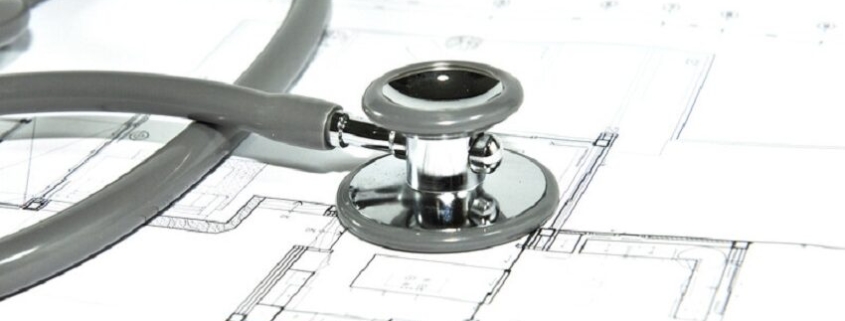U.S. Demographic Trends Strongly Favor Medical Office Real Estate
The dislocation caused by COVID impacted all areas of life and transformed work and leisure for tens of millions of Americans.
The health crisis also prompted an unprecedented population shift over the past two years, which along with an accommodative Federal Reserve, stimulus payments, and a buoyant stock market contributed to a dramatic rise of residential real estate prices in the United States.
The availability of remote work, a tight labor market which shifted power to employees to demand more flexible work arrangements, escape from strict pandemic-related public health measures, a general interest of people to move to a warmer climate, more tax-friendly locations, with better job and salary prospects, a buoyant stock market that lifted household wealth and, of course, rising home prices, and a frantic search for a shrinking inventory of affordable homes all contributed to an unprecedented population shift over the past couple of years.
These trends also favor another area of real estate favored by sophisticated individual investors and institutions, healthcare real estate.
“Before the pandemic, the healthcare sector was characterized by long-term leases, stable occupancy, consistent income streams and quality tenants with stable, long-term leases and high credit ratings,” says Martin Freeman, OrbVest CEO, “as the pandemic recedes we see even more reason for long-term optimism for individuals and institutional investors considering opportunities in this sector.”
OrbVest is a global real estate company investing in income-producing medical commercial real estate in the United States, and is one of a growing number of companies looking to capitalize on the growth and potential of US healthcare real estate.
What Are The Trends?
The National Association of Realtors recently highlighted metropolitan areas in the Sunbelt and Mountain states that saw the highest yearly price gains: Punta Gorda, Fla. (28.7%); Ocala, Fla. (28.2%); Austin-Round Rock, Texas (25.8%); Phoenix-Mesa-Scottsdale, Ariz. (25.7%); Sherman-Denison, Texas (25.1%); Tucson, Ariz. (24.9%); Las Vegas-Henderson-Paradise, Nev. (24.7%); Ogden-Clearfield, Utah (24.7%); Salt Lake City, Utah (24.4%); and Boise City-Nampa, Idaho (24.3%).
Chicago, Milwaukee, New York City, and San Francisco all saw a population decline during the pandemic because of fewer jobs and unfavorable demographic trends. In 2021, New York, California, and Illinois each lost over 100,000 people to outmigration.
According to Redfin, a record 32% of users nationwide were looking to move to a different metro area during the first quarter of 2022.
The 2021 U.S. Moving Migration Patterns Report from North American Moving Services also showed that Illinois, New York, California, New Jersey, and Michigan were the top five states for outbound moves, while Idaho, Arizona, South Carolina, Tennessee, North Carolina, Florida, Texas, and Utah were the top states for inbound moves.
Redfin noted the top 10 places where Americans are considering moving include: Miami; Phoenix, Las Vegas; Sacramento; Tampa; Dallas; Cape Coral, Fla.; North Port, Fla.; San Antonio; Atlanta.
The Marcus & Millichap multifamily market forecast primarily reflects these statistics and trends. The company specifically cited that the Sunbelt and Mountain regions should thrive. Even before the pandemic, the Sunbelt saw significant in-migration, household formation, and employment growth. During the pandemic, this region saw fewer job losses, mainly due to public policy regarding restrictions. The Mountain region is also seeing momentum thanks to rapidly growing populations, a strong quality of life, and affordable living costs.
Let’s take a deeper look at what could be driving these migration trends.
COVID-19
A Pew Research Center study conducted in June 2020 found that over a quarter (28%) cited COVID-19 as a significant driver for why they moved. Many people relocated due to fear of catching the virus while others moved to escape restrictions.
A worldwide pandemic would not have necessarily been a migration driver pre-2020. However, the pandemic indeed exposed a divide between how to handle the pandemic. Blue states such as California, New York, and Illinois had some of the harshest coronavirus restrictions. Michigan also saw significant out-migration due to the collapse of the auto industry and COVID-related public policy. Red states, on the other hand, such as Texas and Florida, kept their conditions largely open. This undoubtedly led to a short-term migration driver for people seeking to earn a living and escape restrictions.
Take New York City, for example. In March 2020, there was a 256% increase in people moving out of the city compared to the same month in 2019. Between March and August 2020, 246,000 people filed a change of address request- an almost 100% increase compared to the same period in 2019.
Remote Work And Learning
Somewhat related to COVID and its shutdown restrictions, the rise of remote work and learning has been another driver for migration. Many students could also be taking advantage of online learning to save money on housing and living expenses.
Climate
The 2020 U.S. Moving Migration Patterns Report noted that the Northwest and Midwest were the regions in the U.S. experiencing the most outbound migrations. Harsh winters are certainly a contributing factor. Meanwhile, the same report cited climate and open space availability as reasons for southern states experiencing great inbound migrations.
According to Moving.com, the weather is the number one reason people move to Florida, for example. Despite hot and humid summers, the state has about 200 sunshine-filled days a year and seasons that tend to be mostly mild and warm. Average winter temperatures also appear to range between the 60s and 70s.
Not every state can boast the same climate that Florida has. However, other places in the Sunbelt and South have mild temperatures of their own that might be contributing to the amount of inbound migration.
Job Growth/Availability
In the Pew Research survey we previously mentioned, a total of 18% gave financial reasons, including job loss, as their motivation to relocate. This driver is also correlated with COVID-19 and policy restrictions. While states hit hardest by restrictions and job losses saw the most out-migration, those who stayed relatively open and kept their job market afloat saw the most in-migration.
Multiple sources and indications show that the Sunbelt, the South, and the Mountain regions are the best locations for job opportunities and job growth.
According to U.S. News, the Top 5 states for job growth are as follows: That’s 2 Sunbelt states, 2 Mountain states, and 1 Southern state.
Other data corroborates this too. According to the Seidman Institute, Idaho was the ONLY state in the U.S. to experience year-over-year job growth for total nonfarm payrolls in January 2021 and is leading year-to-date too.
4 of the Top 5 states leading in job growth based on a 12-month moving average are also all Mountain states: Idaho, Utah, Arkansas, Montana, and South Dakota.
This interactive map from the WorldPopulationReview depicting “Job Growth by State 2021” seems to expand on this data. Notice which regions of the country are lighter shaded (less job growth) and which areas are darker shaded (more job growth).
Income Tax/Affordability
“An income tax increase in a state may cause individuals to out-migrate over time,” says the Cato Institute.
Because of the economic hardships that many Americans have faced, the correlation between state income tax rates, affordability, and migration is not coincidental.
3 of the Top 8 states for in-migration- Florida, Tennessee, and Texas- do not collect state income tax. Meanwhile, other top states for in-migration, Arizona, North Carolina, and South Carolina, have a minimal state income tax.
While growing Mountain States, such as Idaho, do have state-income tax, Mountain States are generally more affordable and have a slower life pace. Compare that to states such as California, New Jersey, and New York. All three of those states are in the Top 5 for most out-migration, and unsurprisingly, their state income tax rates are 13.3%, 10.75%, and 8.82%, respectively.
Impact On The Healthcare Industry
The Sunbelt, South, and Mountain regions have experienced the most in-migration. It is not a coincidence that these regions are also seeing the highest volume of medical office sales.
Medical office sales volume totaled $19.6 billion in 2021 a 40.1% increase from 2020, a significant increase from prior years’ sales ranges of $13 to $14 billion.
The five states with the most MOB square footage under construction are California, Florida, and Texas, New York and Ohio. The same five states also top the list of hospital construction activity.
Houston, Texas is the leading metro market for construction, and other Sun Belt areas like Orlando, Miami, and Atlanta are all in the top 10.
There is a direct correlation between healthcare real estate, demographics, and migration. Sunbelt states have seen investor interest in medical office buildings due to pleasant year-round climates attracting aging boomers and young families seeking to enjoy better weather and a more active lifestyle.
You have to consider the cost of living and the cost of healthcare as well. For the younger population, it is much more affordable to raise a family in the Sunbelt and the South compared to New York City and San Francisco, especially when you consider the cost of healthcare.
For our aging population, consider the essential needs for affordable and convenient healthcare as the 80+ demographic is growing quickly, and outspending every other age on healthcare combined.
The 65-and-older population has increased from 12.8 percent of the population to 16.1 percent. By 2030, it may comprise more than 1/5 of the U.S. population. This has a direct and critical impact on healthcare. According to data from the 2010 Census, more than two-thirds of people in this age group (66.5 percent) see the doctor three or more times a year, up from less than half of those aged 46-64 (44.2 percent).
For one example of how demographics provide a tail wind for segmented and specialized healthcare facilities, look to South Florida, home to the highest concentration of seniors in the country, with more than 3.3 million Floridians aged 65 and older, and 1 in 20 now 80 years old or older.
Migration and Demographics Fueling Medical Office Building Boom
We are witnessing a boom in the medical office building (MOB) real estate market. MedCraft Investment Partners announced the launch of a $500 million joint venture for medical office acquisitions, and, Kayne Anderson Real Estate is getting ready to close a $2.5 billion fund of which approximately half will be allocated to medical offices.
In 2021, 280,000 square feet of medical office space was absorbed – a 77% increase from 2020, according to JLL. medical office vacancy down two basis points to 5.8%, the lowest levels since 2006 and medical office rents rose 5.5% in 2021, according to JLL.
Average net asking rents for MOB space increased by 1.7% in 2021 to $22.61 per square foot — setting a new high for the sector, according to Colliers.
Companies with a track record for success like OrbVest, are able to navigate this competitive marketplace and are attracting a great deal of interest from individual and business investors around the world seeking dollar dividends and an inflation-resistant asset in times of volatility.
“We are mindful of the increasingly competitive market for prime assets and are constantly re-assessing and adjusting OrbVest’s business model to match evolving market conditions,” says Freeman. “We are fortunate that OrbVest is able to leverage the relationships it has built up with brokers and providers of these assets so we can continue to secure almost 75% of our deals off-market, providing a sustainable pipeline to meet investor expectations.”
Key Takeaways
For healthcare real estate, demographic shifts and population migration trends go hand in hand with location and its correlation to healthcare real estate trends.
America is rapidly changing and graying. Our population is not only aging but also taking into account quality of lifestyle more than ever before. Young families want a more affordable, lower-stress and higher-quality lifestyle. Seniors want to enjoy a better climate with affordable and convenient healthcare integrating with their lifestyles. These migration trends preceded the pandemic, but the pandemic accelerated these trends.
If you’re considering investing in healthcare real estate, consider how demographic changes, migration, and how people’s location preferences directly correlate with healthcare properties.
Suppose you can look into crystal ball not 5 years into the future but 10+. In that case, you can unlock a historically strong investment opportunity in medical office buildings and healthcare real estate.
“We believe that healthcare-related commercial real estate in the U.S. should continue its growth as an ageing population and technological progress drives increasing demand for these specialized buildings. We are very excited to be executing successfully in this rapidly growing space,” says Freeman.
Source: Global Banking & Finance Review




